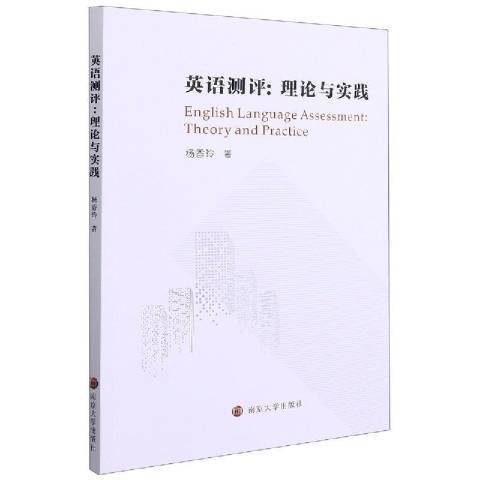《英語測評:理論與實踐》是2021年南京大學出版社出版的圖書。
基本介紹
- 中文名:英語測評:理論與實踐
- 作者:楊香玲
- 出版社:南京大學出版社
- 出版時間:2021年
- 開本:16 開
- 裝幀:平裝
- ISBN:9787305242960

《英語測評:理論與實踐》是2021年南京大學出版社出版的圖書。
《英語測評:理論與實踐》是2021年南京大學出版社出版的圖書。內容簡介本書是隨著國家英語能力等級量表研發、國家外語能力測評體系建設工作的有序推進,作者針對不斷最佳化的頂層設計之下一線英語教師和英語師範生存在的測評理念陳舊,...
《英語測試的理論與實踐》是2003年1月1日外語教學與研究出版社出版的圖書,作者武尊民、 王薔。內容簡介 《英語測試的理論與實踐》講述了:英語測試是英語教師專業知識和技能的一個重要組成部分。大部分中學教師已經充分認識到這一點。我國...
《中國小英語評價測試理論與實踐》是2005年中國電力出版社出版的圖書,作者是魯子問。內容提要 中國小英語評價測試理論與實踐是魯子問等著作,對於英語運用能力評價測試、國小終結性評價測試等的新探討能起到拋磚引玉的作用,以真正實現通過...
英語專業四級測試理論與實踐 《英語專業四級測試理論與實踐》是中國青島海洋大學出版社出版的圖書,作者是韓曉玲。
《大學英語考試710分理論與實踐》是一本2006年東華大學出版社出版的圖書。內容簡介 本書內容包括理論部分、精華部分、寫作語言基礎訓練部分和借鑑模仿部分四部分。目錄 第1章《大學英語六級考試大綱》對寫作的要求與分析 第2章 大學英語...
趙護林,男,翻譯學博士,主要研究方向為語言服務、翻譯理論、翻譯教學與測評。近年來,在SSCI/A&HCI來源期刊等發表論文20餘篇,主持完成MTI教指委項目1項,參與完成國家社科基金項目等4項,參與研製《中國英語能力等級量表》。同時,出版...
《大學英語立體化教材研究:理論與實踐》是楊港創作的語言學著作,首次出版於2020年6月。該書針對大學英語立體化教材的套用進行探索性研究,從正確理解立體化教材的內涵入手,調查其在大學英語教學中的套用現狀。採用量化為主、質化為輔的...
《語言測評:原理與課堂實踐(第2版)》(Language Assessment:Principles and Classroom Practices(2nd Edition))是一部語言測評領域的綜合理論著作,具有很強的實用價值,在全球範圍具有廣泛和深遠的影響力。作者是布朗 (H.Douglas Brown...
《英語新課程改革理論與實踐(第2版)》是為了幫助廣大英語教師積極回應新課程改革提出的挑戰,更好地理解領會英語新課程改革的要求,給予理論的指導和實踐的示範,促進教師實踐新課程能力的提高而編寫。圖書目錄 第一章國外外語教學發展歷程...
《英語教學理論與實踐》是2001年高等教育出版社出版的圖書,作者是田式國。該書是英語教育專業學生用的“英語教育學”或“英語教學法”教材。內容簡介 《中學教師進修高等師範本科教材:英語教學理論與實踐》對英語教育學的一些一般性或...
《英語語法理論與實踐》是2013年9月1日光明日報出版社出版的圖書,作者是李慶新、曹慧玲。內容簡介 《英語語法理論與實踐》是作者根據多年來大學英語教學實踐經驗和研究成果精心編著而成的,參加《英語語法理論與實踐》編著的均為大學英語...
《英語語言教學理論與實踐》是2015年8月21日譯林出版社出版的圖書,作者是David Nunan。內容簡介 外語課程的改革可以分為三個層面:一是巨觀的、戰略性的計畫, 如確定教學理念與設計課程目標、評價目標等;二是策略性層面(Candlin,1984...
叢書既是高中教師新課程培訓教材,也可作為對高等院校本科生、研究生進行高中課程改革理論與實踐教育和研究的參考教材。《高中英語新課程的理論與實踐》是叢書中的一冊,包括教育理論篇、學科素養篇、教學策略篇、課程資源篇、教學技術篇、...
《新課程國小英語理論與實踐》是四川大學出版社出版的一本圖書。內容簡介 本書比較系統地介紹了國小開設英語的理論依據、教學價值,教學意義、目的、特點、原則;著重闡釋在新課標下我國國小英語教學的新觀念,新趨勢,國小英語的課堂教學...
《英語語用理論與實踐研究》是2020年哈爾濱工業大學出版社出版的圖書。內容簡介 《英語語用理論與實踐研究》針對英語教學的基礎理論、功能套用、實踐策略、文化育人等展開系統研究。主要內容包括文學理論基礎及研究、教學中的語類研究與多元...
《大學英語寫作教學理論與實踐》是2009年06月吉林出版集團有限責任公司出版的一部圖書,作者是姜濤。內容簡介 《大學英語寫作教學理論與實踐》包括6個章節和1個結論部分。第一章系統地介紹了當代語言及教學理論對寫作教學的指導作用及其套用...
《新課程國小英語教學理論與實踐》是2011年2月1日由四川大學出版社出版的圖書,作者是黎茂昌、潘景麗。內容簡介 本書主要講述了國小外語教學理論和一些教學實踐的輔助方法等。共十二章。第一章介紹外語教學理論,主要講述語言的習得與學得...
《新課程中學英語教學理論與實踐》是2011年四川大學出版社出版的書籍,作者是黎茂昌。該書旨在更新讀者英語教育理念並搭建一座理論與實踐之間的橋樑,為的英語教學工作提供借鑑,給英語教學研究者提供參考。內容簡介 《新課程中學英語教學:...
和“集體攻堅”相結合 作者簡介 邵帥,中國勞動關係學院外語教學部講師。2004年山東大學外國語學院本科畢業,2007年北京師範大學外文學院研究生畢業。多年從事大學英語教學工作,對大學英語口語教學理論與實踐有著較深入的前期研究。
《大學生英語寫作理論與實踐》是2007年西北工業大學出版社出版的圖書,作者是成洶湧、於翠葉。該書是一本信息量大、涵蓋面廣、理論與實踐相結合的英語寫作工具書。編輯推薦 本書系統地講解了敘述文、描寫文、議論文、說明文四種常見文體...
《大學英語教學理論與實踐》是2013年5月1日南開大學出版社出版的圖書,作者是陳品。內容簡介 由陳品主編的《大學英語教學理論與實踐》集涉及大學英語教學與管理、英語語言學與套用語言學、英語教學理論與方法、文學理論研究及文學作品分析...
《大學英語自主學習理論研究與實踐》是2010年西北工業大學出版社出版的圖書,作者是劉向紅。內容簡介 《大學英語自主學習理論研究與實踐》包括兩大部分:自主學習研究理論篇和自主學習研究實踐篇。第一部分包括以下內容:自主學習產生的歷史...
《英語教學的理論與實踐》中英語作為國際上最為通用的語言之一,已經成為我們對外交流活動中的一種必要工具。培養在校大學生良好的英語綜合套用能力和英語交際能力是教學改革的目的和重點。英語學習能否取得成功,除了需要高效的英語學習方法外...
《英語寫作:理論技巧與實踐(上冊)》主要講授遣詞的原則和方法、句子的類型和寫法、段落的整體性、連貫性和展開段落的各種技巧、標點符號的用法等寫作的基本知識和技能,輔之以具有針對性和實用性的練習。《英語寫作:理論技巧與實踐(上冊)...
他在考試的效度驗證領域有超過20年的經驗,對很多國際知名英語測試的設計、研發、效度驗證做出了卓越貢獻。LYNDA TAYLOR,劍橋大學英語考試委員會委員,劍橋大學套用語言學和語言測試博士,擁有35年語言教學理論與實踐經驗。編著有:Cambridge ...
